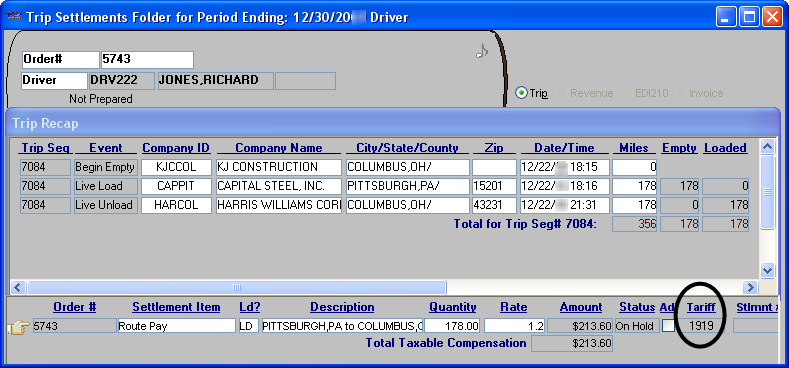Rate index hierarchy
Because a trip could fit the restrictions set in many indexes, ranging from indexes having very general restrictions to those that are very specific, the system looks for the best match between a trip and the rate indexes. Field-by-field, the restrictions in each index are examined for a match with the corresponding fields on the trip, or on records associated with the trip.
Using a hard-coded sort order hierarchy, the system filters the indexes from best match to worst match. Each time a field on a record is compared to a corresponding restriction field in an index, one of three things happens. The field on the record:
Matches the corresponding index field.
The system accepts the index for potential use and attempts to match the trip to the next index field.
The system accepts the index for potential use and attempts to match the trip to the next index field.
Does not match the corresponding index field.
The system rejects this rate index for use with this trip, and it goes to the next rate index.
The system rejects this rate index for use with this trip, and it goes to the next rate index.
Has a value of UNKNOWN.
The system accepts the index for potential use and tries to match the trip to the next index field. However, this index will have a lower priority than one having an exact match.
The system accepts the index for potential use and tries to match the trip to the next index field. However, this index will have a lower priority than one having an exact match.
The restrictions you set in a rate index determine when it will be pulled. If you add enough restrictions or, more accurately, certain restrictions, the rate is likely to pull as you expect.
This table lists the hard-coded sort order hierarchy. The fields are numbered according to the sort order the system uses to determine which rate is the best match for a trip.
Note: The same hierarchy is used for billing rates and pay rates, except as noted here:
1. Fields marked with a single asterisk (*) exist only on the index in the Edit Billing Rate Schedules Folder.
2. Fields marked with two asterisks (**) exist only on the index in the Edit Settlement Schedules Folder.
Sort order hierarchy | |||||||
|---|---|---|---|---|---|---|---|
1 | Master Order # | 20 | DrvType1 (Driver Type 1) | 39 | Destination State | 58 | OtherType 2 (Bill To company) |
2 | Bill To | 21 | DrvType2 (Driver Type 2) | 40 | RevType1 (Revenue Type 1) | 59 | **Terminal (driver) |
3 | Divis. of /Parent (Parent Company) | 22 | DrvType3 (Driver Type 3) | 41 | RevType2 (Revenue Type 2) | 60 | **Terminal (tractor) |
4 | **Drv ID (Driver ID) | 23 | DrvType4 (Driver Type 4) | 42 | RevType3 (Revenue Type 3) | 61 | **Terminal (trailer) |
5 | **Trc Number (Tractor ID) | 24 | TrcType1 (Tractor Type 1) | 43 | RevType4 (Revenue Type 4) | 62 | **Lead/Co Driver |
6 | **Trl Number (Trailer ID) | 25 | TrcType2 (Tractor Type 2) | 44 | Company | 63 | **StopOtherType1 |
7 | **Payto (driver) | 26 | TrcType3 (Tractor Type 3) | 45 | LghType1 | 64 | **StopOtherType2 |
8 | **Payto (tractor) | 27 | TrcType4 (Tractor Type 4) | 46 | **Loaded | 65 | **Company (driver) |
9 | **Payto (trailer) | 28 | OtherType 1 (order by company) | 47 | Team/Single | 66 | **Fleet (driver) |
10 | **Payto (carrier) | 29 | OtherType 2 (order by company) | 48 | Board Carrier | 67 | **Division (driver) |
11 | Ord’d By (Ordered By) | 30 | Origin Company | 49 | *Terms | 68 | **Domicile |
12 | Route | 31 | Origin City | 50 | *Trip Definition or Region Origin | 69 | **Team Leader |
13 | Carrier (carrier ID) | 32 | Origin Zip | 51 | *Region Destination | 70 | **Company (tractor) |
14 | Freight (Commodity Code) | 33 | Origin County | 52 | LghType2 | 71 | **Fleet (tractor) |
15 | Fgt Class (Commodity Class) | 34 | Origin State | 53 | **LghType3 | 72 | **Division (tractor) |
16 | TrlType1 (Trailer Type 1) | 35 | Destination Company | 54 | **LghType4 | 73 | **Company (trailer) |
17 | TrlType2 (Trailer Type 2) | 36 | Destination City | 55 | **Third Party ID | 74 | **Fleet (trailer) |
18 | TrlType3 (Trailer Type 3) | 37 | Destination Zip | 56 | **Third Party Type | 75 | **Division (trailer) |
19 | TrlType4 (Trailer Type 4) | 38 | Destination County | 57 | OtherType 1 (Bill To company) | ||
The fields listed below are not included in the sort order hierarchy:
Count Unit | Max Dist (O-D) | Min Dist (O-D) | Stop Offs |
Distance Unit | Max Distance | Min Distance | To |
Event | Max Volume | Min Volume | Volume Unit |
From | Max Weight | Min Weight | Weight Unit |
Max Count | Min Count | Off-Route |
To ensure that the correct rate is pulled for an order, keep the sort order hierarchy in mind when making entries in a rate index.
The following example shows how the sort order affects the pulling of rates. Suppose:
Your company pays both tractors and trailers.
You have set up a rate for tractor pay and used a TrcType field as a restriction on the index.
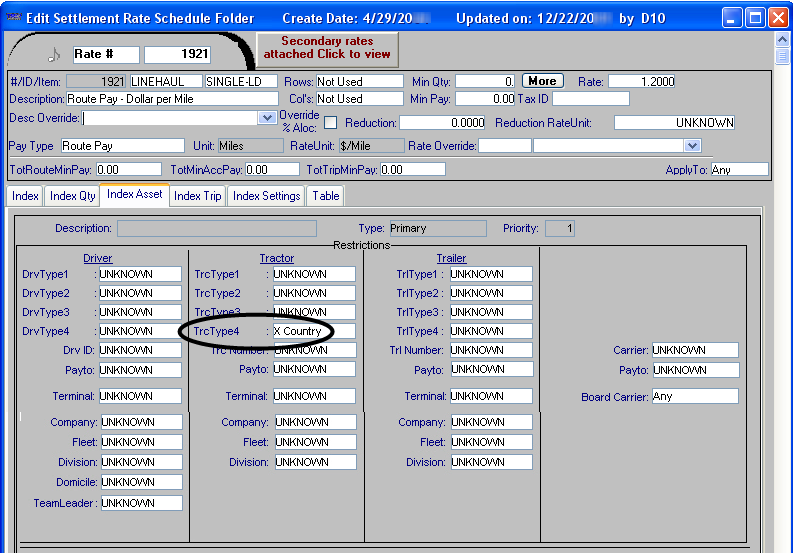
You have also set up a separate rate for trailer pay and used a TrlType field as a restriction on the index.
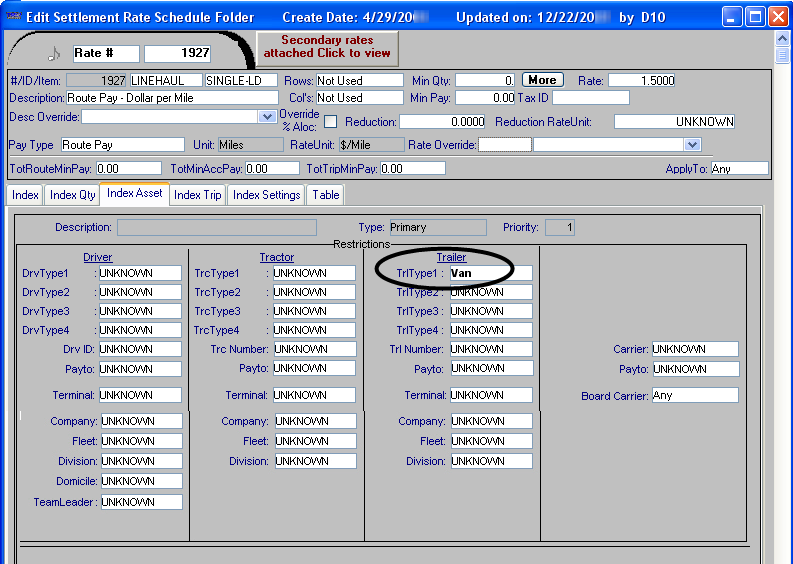
You have a trip for which the tractor is to be paid; however, the trip matches both rates.
When you use the Compute function to pay the tractor, the system pulls the trailer rate instead of the tractor rate.
This happened because TrlTypes is listed before TrcTypes in the rate index sort order hierarchy. Since the trailer rate and the tractor rate each had only one restriction field set in the index, the system used the sort order to determine which rate was applicable.
Note: To resolve the problem, you can use the Apply To field in the rate header to specify the resource type for which the rate is applicable.
Keep in mind that it is not the number of index restrictions that determine which rate to apply. It is the weight of the restrictions. Consider the following example.
Pay rate schedule 1919 has one restriction:
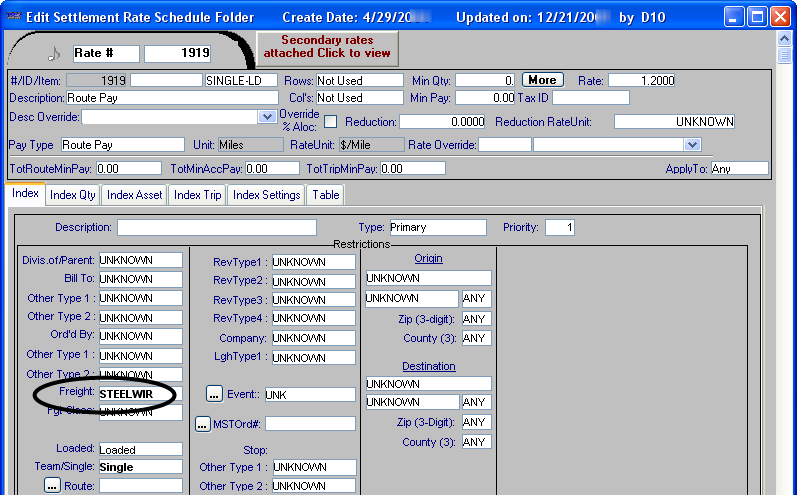
Pay rate schedule 1920 has ten restrictions:
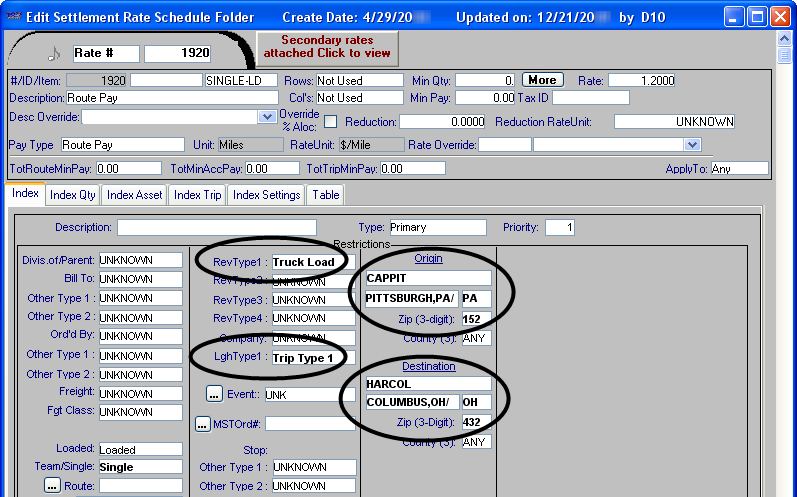
Order 5743 matches both rate schedules.
However, when the trip is rated, notice that Rate # 1919 is applied, even though it has only one restriction and Rate #1920 has ten restrictions. This occurs because Freight is used as a restriction on Rate #1919. Freight is higher up in the index hierarchy than any of the restrictions used on Rate #1920.
